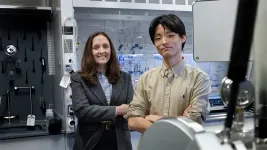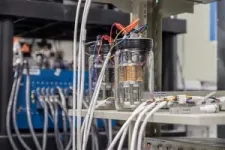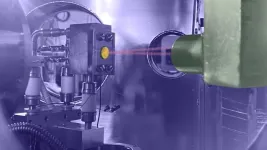(Press-News.org) From laptops to electric vehicles, lithium-ion batteries power everyday life. However, as demand for longer-lasting devices threatens to outstrip the energy that lithium-ion supplies, researchers are on the hunt for more powerful batteries.
A team led by Kelsey Hatzell, an associate professor of mechanical and aerospace engineering and the Andlinger Center for Energy and the Environment, has uncovered insights that could help power a new type of battery, called an anode-free solid-state battery, past lithium-ion’s limitations.
By understanding how these advanced solid-state batteries operate and fail under different conditions, Hatzell’s research is informing efforts to improve their performance and manufacturability, helping them to move from the lab to the real world to support the clean energy transition.
“If we can successfully introduce these up-and-coming batteries, we can access energy densities that are impossible with conventional batteries,” said Hatzell. “It would mean that your laptop and your phone would last longer on a charge. It could allow electric vehicles to hit over 500 miles on a charge. It could even move us toward feats that seem impossible today, like electrified aviation.”
The papers stem from Hatzell’s involvement as the manufacturing leader for Mechano-Chemical Understanding of Solid Ion Conductors (MUSIC), an Energy Research Frontier Center supported by the U.S. Department of Energy whose members are unlocking fundamental insight to advance electrochemical energy storage systems. MUSIC is led by the University of Michigan at Ann Arbor and encompasses 16 faculty members from across nine institutions, including Princeton University.
"Solid-state batteries can revolutionize energy storage technology, but a significant challenge is developing a process for manufacturing them at scale," said energy storage expert Jeff Sakamoto, director of MUSIC and a professor of materials and mechanical engineering at the University of California-Santa Barbara. “Hatzell’s work is playing an important role in improving the solid-state manufacturing process, and her work with MUSIC is an example of how integrated research approaches can help overcome complex, multidisciplinary challenges.”
Batteries: A look under the hood
Conventionally, batteries feature two electrodes — one positive (commonly called the cathode) and one negative (the anode). Each electrode is paired with a thin metal foil called a current collector that connects the battery to the external circuit, and the two electrodes are separated from one another by an electrolyte.
The movement of ions between the two electrodes powers the battery. When the battery charges, ions flow from the positive electrode, through the electrolyte, and to the negative electrode. When the battery is discharged, the flow of ions reverses directions.
Compared to the familiar lithium-ion battery, the batteries that Hatzell and her group study are different at two fundamental levels.
First, while the electrolyte in lithium-ion batteries is a liquid, the electrolyte in a solid-state battery is — as its name implies — a solid.
The difference is significant. Solid-state batteries can store more energy in less space than lithium-ion batteries, opening the door to longer driving ranges for electric vehicles. They can also operate with high performance at a wider range of temperatures and promise greater durability than their lithium-ion counterparts.
Second, the batteries that Hatzell studies are ‘anode-free,’ meaning that the negative electrode has been removed. Instead, ions flow from the positive cathode directly to the current collector at the opposite end of the battery. The ions then plate onto the current collector itself, forming a thin metal layer as the battery charges.
Removing the anode makes the battery cheaper and even more compact than standard solid-state batteries. At the same time, anode-free solid-state batteries avoid a major bottleneck to deployment compared to standard solid-state batteries, as the anode in most solid-state batteries is a lithium metal foil that requires specialized manufacturing approaches.
“If you could assemble a battery without a lithium metal anode, you would greatly cut costs while leveraging existing manufacturing processes,” Hatzell said. “Both of these advantages are key if you want to make a dent in the battery market.”
Cracking under pressure
While these next-generation batteries sound good on paper, they face many challenges in practice. Foremost among those is ensuring good contact between the solid electrolyte and the current collector. This ensures that as the ions travel through the electrolyte, they evenly deposit on the current collector when the battery is charged and evenly strip from the current collector when it is discharged.
In one paper, published Feb. 22 in ACS Energy Letters, Hatzell and first-author Se Hwan Park, a postdoctoral researcher in her group, explored how factors such as the pressure applied to the battery influence the contact between the electrolyte and the current collector.
“During charging and discharging, the battery is undergoing an electrochemical reaction. By applying an external pressure, we’re also introducing mechanical forces,” said Park. “It’s a very complex system, with many interacting forces.”
Unlike the liquid electrolytes in traditional batteries that can easily change shape, solid electrolytes are rigid. As such, any defects or irregularities on the surface of either the electrolyte or the current collector in a solid-state battery negatively impact the quality of contact between the two components.
The team found that applying low pressures to the system did not do enough to improve the uneven contact caused by those surface irregularities, resulting in ions plating and stripping unevenly on the current collector as the battery was charged and discharged. Areas with good contact became hotspots, while areas with poor contact formed voids. Ultimately, the uneven plating led to the formation of sharp metal filaments that, like tiny needles, could pierce the solid electrolyte and cause the battery to short-circuit.
At high pressures, the researchers encountered a different problem. While they found that higher pressures favored better contact and more uniform plating and stripping, the high pressure forced the electrolyte and the current collector together so intensely that any imperfections on either were magnified until the mechanical stress caused fractures to form.
Thus, low and high pressure caused the batteries to fail, but for different reasons — either too little or too much contact between the electrolyte and current collector. Hatzell said both failure modes give new insight into the best ways to make and operate anode-free solid-state batteries.
“The Holy Grail in this area will be to figure out how to maintain solid contact at low pressures, since manufacturing a defect-free electrolyte is practically impossible,” Hatzell said. “If we want to realize the potential of these batteries, we have to solve the contact issue.”
A silver lining
While the results of their work highlighted the importance of even contact between the electrolyte and current collector, a second paper from Hatzell’s group, published Dec. 19 in Advanced Energy Materials, investigated a way to achieve that contact.
In this paper, the researchers demonstrated it was possible to achieve more uniform ion plating and stripping by applying a thin coating between the current collector and the electrolyte to facilitate better ion transport.
In their work, the researchers tested several of these coatings, called interlayers, to study how their structure and composition impacted how ions were plated while the battery charged.
Aligning with previous research, the team found that interlayers made from carbon and silver nanoparticles were best at achieving a uniform metal deposition. The silver in these interlayers formed alloys with ions during battery charge and discharge, enabling even plating and stripping from the current collector.
However, the team found that the size of the silver nanoparticles matters. Interlayers with larger, 200-nanometer silver particles formed spindly, uneven metal structures on the current collector. These wire-like structures made the battery less durable, leading to reduced capacity and eventual battery failure over several charging cycles.
Interlayers with smaller, 50-nanometer silver particles supported denser and more uniform structures, leading to batteries with greater stability and higher power output.
“Only a few groups have investigated the actual processes that occur in these interlayers,” said Park. “Among other findings, we demonstrated that the stability of these systems is linked to the morphology of the metal as it plates and strips from the current collector.”
The difference, Park explained, boils down to the alloying process, which causes the silver particles in the interlayer to expand. This expansion leads to localized stress that can alter the interlayer’s structure, forming and expanding pores that impede the flow of ions. When the nanoparticles were smaller and thus better dispersed, the stress was more evenly distributed across the interlayer.
“These findings can inform the strategy for fabricating these interlayers,” Park said. “By reducing the size of the silver particles, we can make sure that we only get the advantages of the silver in the interlayer, which, in turn, could allow us to achieve good contact and uniform plating even at low pressures.”
Charging into the future
In addition to her group’s experimental work, Hatzell and several MUSIC collaborators reviewed the current state of anode-free solid-state batteries in a paper published Jan. 2 in Nature Materials, summarizing recent progress and identifying outstanding research gaps.
One of the biggest gaps in battery research, Park and Hatzell agreed, is demonstrating whether successful techniques in the lab can be scaled and incorporated into the existing battery manufacturing supply chain. There, too, they are hopeful.
After solid-state batteries have been promised as the future of energy storage for several years, Hatzell said that countries like China, Japan, and South Korea now have near-term plans to bring solid-state batteries to market. Samsung, for example, has vowed to begin mass-producing solid-state batteries by 2027, and Toyota has a mass production target of 2030.
“The challenge will be getting from research to the real world in only a few years,” said Hatzell. “Hopefully the work we’re doing now at MUSIC can underpin the development and deployment of these next-generation batteries at a meaningfully large scale.”
The paper, “Filament-induced failure in Li-free solid-state batteries,” was published February 22, 2025 in ACS Energy Letters. In addition to Park and Hatzell, co-authors include Abhinand Ayyaswamy, Bairav Vishnugopi, and Partha Mukherjee of Purdue University; Jonathan Gjerde, W. Beck Andrews, and Katsuyo Thornton of University of Michigan, Ann Arbor; and Michael Drakopoulos, Nghia Vo, and Zhong Zhong of Brookhaven National Laboratory. The work was supported by the MUSIC Energy Frontier Research Center, funded by the Department of Energy.
The paper, “Lithium kinetics in Ag-C porous interlayer in reservoir-free solid-state batteries,” was published December 19, 2024 in Advanced Energy Materials. In addition to Park and Hatzell, co-authors include Kaustubh Naik, Bairav Vishnugopi, and Partha Mukherjee of Purdue University. The work was supported by the MUSIC Energy Frontier Research Center, funded by the Department of Energy.
The perspective paper, “Electro-chemo-mechanics of ‘anode-free’ solid-state batteries,” was published January 2, 2025 in Nature Materials, with Stephanie Elizabeth Sandoval of Georgia Institute of Technology and Catherine Haslam of University of Michigan, Ann Arbor as co-first authors and Matthew McDowell of Georgia Institute of Technology as corresponding author. Including Park and Hatzell, the paper’s co-authors are Bairav Vishnugopi and Partha Mukherjee of Purdue University; Daniel Liao, Jeong Seop Yoon, and Neil Dasgupta of University of Michigan, Ann Arbor; Jeff Sakamoto of University of Michigan, Ann Arbor and University of California, Santa Barbara; and Yixian Wang, David Mitlin, and Donald Siegel of The University of Texas at Austin. The work was supported by the MUSIC Energy Frontier Research Center, funded by the Department of Energy.
END
Leading the charge to better batteries
2025-02-27
ELSE PRESS RELEASES FROM THIS DATE:
Consequences of overplanting rootworm-resistant maize in the US Corn Belt
2025-02-27
Widespread use of genetically engineered Bt maize, designed to combat rootworm pests, has led to overplanting and pest resistance, jeopardizing the crop’s long-term effectiveness, according to a new study. The findings – informed by data from ten U.S. “Corn Belt” states – estimate that this overuse has cost U.S. farmers $1.6 billion in economic losses, emphasizing the need for improved seed diversity, transparency, and farmer decision-making to sustain transgenic crop benefits. “If current and future related innovations are managed as Bt maize hybrids have been,” say the authors, “we risk entering ...
The distinct role of Earth’s orbit in 100-thousand-year glacial cycles
2025-02-27
The ebb and flow of Pleistocene glacial cycles is not random; it follows a predictable pattern dictated by the distinct and deterministic influence of Earth’s orbital geometry, according to a new study. The findings highlight the roles of precession, obliquity, and eccentricity – factors influencing the tilt and movement of Earth's axis, and the shape of Earth's orbit around the Sun – in glacial transitions. They also establish a predictive model for past and future glacial cycles based ...
Genome-based phylogeny resolves complicated Molluscan family tree
2025-02-27
From octopuses to snails, the complicated molluscan family tree has now been mapped in unprecedented detail, researchers report. This includes sequences for 13 new complete genomes from across the phylum. The genome-based phylogeny helps to resolve long-standing evolutionary debates and provides new insights into how the extraordinary diversity of species emerged from a single common ancestor. The phylum Mollusca is highly diverse with myriad morphological, ecological, and behavioral adaptions spanning both terrestrial and aquatic environments. The most well-known groups – bivalves, ...
Studying locusts in virtual reality challenges models of collective behavior
2025-02-27
A study of locusts navigating in a novel virtual reality (VR) environment challenges traditional models of collective swarming behavior, researchers report. The findings show that the insects don’t just follow their neighbors like self-propelled particles but instead rely on internal cognitive decision-making processes to navigate as a collective. Collective motion, a phenomenon found widely in nature, has traditionally been described using "self-propelled particle" theoretical models from physics. These “classical” models of collective behavior, like ...
ACC, AHA issue new acute coronary syndromes guideline
2025-02-27
The American College of Cardiology and the American Heart Association today released an updated clinical practice guideline for managing individuals experiencing acute coronary syndrome (ACS). The guideline incorporates new evidence and updated recommendations to improve quality of care and outcomes. The 2025 ACC/AHA/ACEP/NAEMSP/SCAI Guideline for the Management of Patients With Acute Coronary Syndromes is published simultaneously today in JACC, the flagship journal of the American College of Cardiology, and in the American Heart Association’s flagship journal Circulation.
ACS includes a ...
Scientists match Earth’s ice age cycles with orbital shifts
2025-02-27
(Santa Barbara, Calif.) — Beginning around 2.5 million years ago, Earth entered an era marked by successive ice ages and interglacial periods, emerging from the last glaciation around 11,700 years ago. A new analysis suggests the onset of the next ice age could be expected in 10,000 years’ time.
An international team, including researchers form UC Santa Barbara, made their prediction based on a new interpretation of the small changes in Earth’s orbit of the sun, which lead to massive shifts in the planet’s climate over periods of thousands of years. The study tracks the natural cycles of the planet’s climate over a period ...
Quantum interference in molecule-surface collisions
2025-02-27
The quantum rules shaping molecular collisions are now coming into focus, offering fresh insights for chemistry and materials science.
When molecules collide with surfaces, a complex exchange of energy takes place between the molecule and the atoms composing the surface. But beneath this dizzying complexity, quantum mechanics, which celebrates its 100th anniversary this year, governs the process.
Quantum interference, in particular, plays a key role. It occurs when different pathways that a molecule can take overlap, resulting ...
Discovery of a common ‘weapon’ used by disease-causing fungi could help engineer more resilient food crops
2025-02-27
The discovery of a powerful “weapon” used by many disease-causing fungi to infect and destroy major food crop staples, such as rice and corn, could offer new strategies to bolster global food security, according to researchers from The Australian National University (ANU) in collaboration with scientists in Germany and the United States.
Like humans, many fungi rely on plants as a food source. This impacts the yield of food crops. It’s estimated farmers lose between 10 to 23 per cent of their crops to fungal disease every year.
The global research team discovered that an enzyme known as a ‘NUDIX hydrolase’ is ...
University of Oklahoma researcher to create new coding language, computing infrastructure
2025-02-27
NORMAN, OKLA. – In an increasingly data-saturated world, computing infrastructure innovations are needed to make sense of new types of information. Richard Veras, a professor in the School of Computer Science at the University of Oklahoma, has received a National Science Foundation Faculty Early Career Development Program (CAREER) award to develop such an innovation by creating more efficient infrastructure for the computation of sparse and irregular data.
Big data – datasets that are challenging to manage using traditional processing tools due to size and complexity, such as social ...
NASA’s Hubble provides bird’s-eye view of Andromeda galaxy’s ecosystem
2025-02-27
Located 2.5 million light-years away, the majestic Andromeda galaxy appears to the naked eye as a faint, spindle-shaped object roughly the angular size of the full Moon. What backyard observers don't see is a swarm of nearly three dozen small satellite galaxies circling the Andromeda galaxy, like bees around a hive.
These satellite galaxies represent a rambunctious galactic "ecosystem" that NASA's Hubble Space Telescope is studying in unprecedented detail. This ambitious Hubble Treasury Program used observations from more than a whopping 1,000 Hubble orbits. Hubble's optical stability, clarity, and efficiency ...





